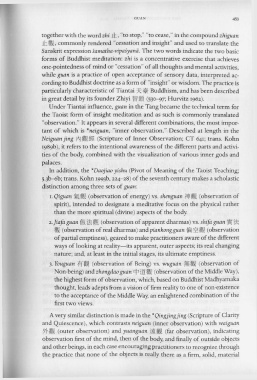Page 493 - The Encyclopedia of Taoism v1_A-L
P. 493
G UAN 453
together with the word zhi 11:., "to stop," "to cease," in the compound zhiguan
Jt WI" commonly rendered "cessation and insight" and used to translate the
Sanskrit expression samatha-vipaSyana. The two words indicate the two basic
forms of Buddhist meditation: zhi is a concentrative exercise that achieves
one-pointedness of mind or "cessation" of all thoughts and mental activities,
while guan is a practice of open acceptance of sensory data, interpreted ac-
cording to Buddhist doctrine as a form of "insight" or wisdom. The practice is
particularly characteristic of Tiantai *- ~ Buddhism, and has been described
in great detail by its founder Zhiyi ~ ~ (530-97; Hurvitz 1962).
Under Tiantai influence, guan in the Tang became the technical term for
the Taoist form of insight meditation and as such is commonly translated
"observation." It appears in several different combinations, the most impor-
tant of which is *neiguan, "inner observation." Described at length in the
Neiguan jing r*.J W?J~ (Scripture of Inner Observation; CT 641; trans. Kohn
1989b), it refers to the intentional awareness of the different parts and activi-
ties of the body, combined with the visualization of various inner gods and
palaces.
In addition, the *Daojiao yishu (Pivot of Meaning of the Taoist Teaching;
5-3b- 6b; trans. Kohn 1993b, 224- 28) of the seventh century makes a scholastic
distinction among three sets of guan:
1. Qiguan ~ft (observation of energy) vs. shenguan ;f$ft (observation of
spirit), intended to designate a meditative focus on the physical rather
than the more spiritual (divine) aspects of the body.
2.}iafaguan -W?tft (observation of apparent dharmas) vs. shifaguan ff?t
ft (observation of real dharmas) and piankongguan {,\jU:2ft (observation
of partial emptiness), geared to make practitioners aware of the different
ways of looking at reality- its apparent, outer aspects; its real changing
nature; and, at least in the initial stages, its ultimate emptiness.
3. Youguan ~WI. (observation of Being) vs. wuguan ~Wl (observation of
Non-being) and zhongdao guan i:\=Iilift (observation of the Middle Way),
the highest form of observation, which, based on Buddhist Madhyamaka
thought, leads adepts from a vision of firm reality to one of non-existence
to the acceptance of the Middle Way, an enlightened combination of the
first two views.
A very similar distinction is made in the *Qingjingjing (Scripture of Clarity
and Quiescence), which contrasts neiguan (inner observation) with waiguan
?'~tIllL (outer observation) and yuanguan itft (far observation), indicating
observation first of the mind, then of the body, and finally of outside objects
and other beings, in each case encouraging practitioners to recognize through
the practice that none of the objects is really there as a firm, solid, material

